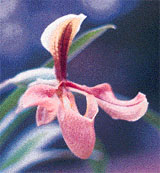Blossoms in the dust
 Sikkim is known for its orchids. The state is home to about 600 species of orchids, including the famous 'lost orchid' - Paphiopedilum fairaeanum (Asian lady's slipper orchid). There are about 80 species considered important by botanists. These are classified into five groups - Cymbidium, Pleione, Coelogynes and Dendrobium species, and bulbophyllums. The 33 Dendrobium species native to Sikkim account for half the species of that genus found in the India.
Sikkim is known for its orchids. The state is home to about 600 species of orchids, including the famous 'lost orchid' - Paphiopedilum fairaeanum (Asian lady's slipper orchid). There are about 80 species considered important by botanists. These are classified into five groups - Cymbidium, Pleione, Coelogynes and Dendrobium species, and bulbophyllums. The 33 Dendrobium species native to Sikkim account for half the species of that genus found in the India.
The diversity of climatic conditions under which orchids grow is tremendous. From a lower elevation up to an altitude of 4,000 m, orchids thrive in a broad habitat - some species grow only on trees (called epiphytes), some grow in the soil and others are climbers. Species like Dendrocolla arachnites flower for a time span of as little as 12 hours, while others like Galeola falconeri grow to a height of three metres before they flower.Some orchids are peculiar in their flowering, with shoots that bore into the soil and bloom underground, others are odd in that they live off decaying matter (saprophytes like Galeola species). There is even an orchid - Microstylis aphylla - that is parasitic.
Orchids are in bloom throughout the year. However, the peak flowering seasons are from February to April and from October to December. The greatest value of these flowers is aesthetic and they are mostly exported. The tender buds of some orchids, such as Cymbidium ensifolium, Cymbidium gammieanum and Cyperorchis elegans, are used for culinary purposes in tribal areas.
There has been a perceptive decline in orchids in both number and species. The principal reason is their vulnerability. Epiphytic species constitute some 62 per cent of the orchid family. Increasing population pressure and tourism has led to indiscriminate felling of trees. When trees critical for the survival of epiphytic species are felled, these plants die out in the area. Moreover, they are easy prey for commercial nurseries which uproot and transplant whole plants. Being adapted to specific environmental conditions, orchids frequently do not survive in nurseries. When they die, they are usually replaced by a fresh batch, leading to further decline in orchid populations.
